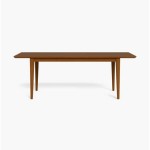Determining the Optimal Dining Room Table Chandelier Height
Choosing and installing a chandelier above a dining room table requires careful consideration of several factors. The height at which the chandelier is hung significantly impacts both the aesthetic appeal and the functionality of the dining space. Hanging it too high can make the chandelier appear insignificant, while hanging it too low can obstruct views and create a sense of confinement. Achieving the ideal height ensures the chandelier effectively illuminates the table, complements the room's décor, and allows for comfortable interaction among diners.
Several conventional guidelines offer a starting point for determining the appropriate height, but these guidelines should be adapted to suit specific circumstances. Factors such as ceiling height, table size, and the chandelier's dimensions and design all play a role in making the final decision. Prior planning and attention to detail will result in a dining room that is both visually pleasing and perfectly lit.
Standard Guidelines for Chandelier Height Above a Dining Table
The generally accepted rule of thumb is to hang a chandelier 30 to 36 inches above a dining table with a standard 8-foot ceiling. This measurement is taken from the bottom of the chandelier to the tabletop. When the ceiling is higher than 8 feet, the chandelier should be raised an additional 3 inches for each additional foot of ceiling height. For example, in a room with a 9-foot ceiling, the chandelier should hang 33 to 39 inches above the table. This adjustment maintains visual balance and ensures adequate headroom.
These measurements serve as a baseline, and slight adjustments may be necessary based on personal preferences and the specific characteristics of the chandelier. A more elaborate or visually heavy chandelier might benefit from being hung slightly higher to prevent it from feeling overwhelming. Conversely, a simpler or more minimalist chandelier may require a slightly lower placement to command attention and provide adequate illumination. It's crucial to consider the chandelier's overall design and visual weight when determining the final height.
Furthermore, it’s important to account for the height of any decorative elements extending below the main body of the chandelier. If the chandelier features crystals or other dangling ornaments, the measurement should be taken from the lowest point of these elements to the tabletop. This ensures that these decorative features do not obstruct views or pose a hazard to diners.
Considering Ceiling Height and Room Proportions
Ceiling height is a primary determinant of chandelier height above the dining table. As previously mentioned, the standard guidelines recommend adding 3 inches of height for each foot above the standard 8-foot ceiling. This scaling ensures that the chandelier remains proportionally balanced within the room. However, other factors related to the room's overall proportions should also be considered. A large dining room with high ceilings might benefit from a larger, more substantial chandelier hung slightly higher than the standard calculation would suggest. This helps to fill the vertical space and create a more dramatic focal point.
Conversely, a smaller dining room with lower ceilings may require a smaller, less imposing chandelier hung slightly lower to avoid overwhelming the space. In such cases, it is particularly important to minimize the distance between the bottom of the chandelier and the tabletop to maximize headroom and prevent the room from feeling cramped. Careful consideration of the room's dimensions and proportions is essential for achieving a harmonious and visually appealing outcome.
In situations involving vaulted or sloped ceilings, determining the ideal chandelier height can be more challenging. The general principle remains the same: maintain visual balance and ensure adequate headroom. However, the angle of the ceiling must be taken into account. In a vaulted ceiling situation, the chandelier should typically be hung lower than it would be in a room with a flat ceiling of the same height. This is because the angle of the ceiling can make the chandelier appear higher than it actually is. The point from which the measurement is taken, whether it’s the highest or lowest point of the ceiling, also warrants careful consideration based on where the dining table is positioned relative to the slope.
The Impact of Chandelier Size and Style
The size and style of the chandelier are crucial considerations when determining its appropriate height above the dining table. A large chandelier, particularly one with a wide diameter, can easily overwhelm a smaller dining room or a small dining table if it is hung too low. In such cases, it may be necessary to raise the chandelier slightly higher than the standard guidelines would suggest, even if the ceiling height is relatively low. This provides adequate headroom and prevents the chandelier from dominating the space.
The style of the chandelier can also influence the optimal height. A more ornate or traditional chandelier with intricate details and numerous light sources may benefit from being hung slightly higher to allow its design to be fully appreciated. This provides a better viewing angle and prevents the details from being obscured. A simple, modern chandelier with a clean, minimalist design may be hung slightly lower to create a more intimate and focused lighting effect.
Furthermore, consider the shape of the dining table. A round table often works well with a chandelier that has a circular or spherical shape, while a rectangular table is typically complemented by a chandelier with a linear or elongated design. The height of the chandelier should be adjusted to maintain visual harmony between the chandelier and the table's shape. In cases where the chandelier's dimensions are significantly different from the table's shape, it may be necessary to experiment with different heights to find the most visually pleasing arrangement.
When a multi-tiered chandelier is involved, the lowest tier's distance from the tabletop is the most critical measurement. This is because this tier is the closest to the diners and is the most likely to obstruct views if hung incorrectly. The upper tiers should be proportionally spaced to ensure a visually balanced and cohesive design.
Practical Considerations: Visibility and Functionality
Beyond aesthetic considerations, the height of the chandelier should also be determined by practical concerns related to visibility and functionality. The primary purpose of a dining room chandelier is to provide adequate illumination for the dining table. If the chandelier is hung too high, it may not provide sufficient light for dining, making activities such as reading or having conversations more difficult. If the chandelier is hung too low, it can create glare and discomfort, and may even impede the ability to see other diners across the table.
The type of light bulbs used in the chandelier also plays a role in determining the optimal height. Brighter light bulbs may require the chandelier to be hung slightly higher to reduce glare, while dimmer light bulbs may necessitate a lower placement to provide sufficient illumination. It's important to choose light bulbs that are appropriate for the chandelier and the dining room's overall lighting needs. Dimmable light bulbs offer flexibility to adjust the brightness as needed.
Another practical consideration is the potential for accidental contact with the chandelier. In households with children or pets, it is essential to ensure that the chandelier is hung high enough to prevent accidental bumps or collisions. This is particularly important in areas with high foot traffic. If there is a risk of accidental contact, it may be necessary to raise the chandelier slightly higher than the standard guidelines would suggest, even if it compromises the aesthetic appeal slightly.
The ease of cleaning and maintenance is another factor to consider. A chandelier that is hung too high may be difficult to reach for cleaning, while a chandelier that is hung too low may be more prone to collecting dust and debris. Striking a balance between accessibility and visual appeal is crucial for ensuring that the chandelier remains in good condition and continues to provide optimal lighting for years to come. This may influence the choice of chandelier design, opting for designs that are easier to clean or replacing difficult-to-reach components.
Finally, it is beneficial to visually test the chandelier height before making the final installation. A temporary suspension system, such as a rope or chain, can be used to hold the chandelier at different heights. This allows you to assess the visual impact and functionality of the lighting from various vantage points within the dining room. This trial-and-error process helps to ensure that you make the right decision and achieve the perfect balance of aesthetics and practicality.

How To Size A Dining Room Chandelier 3 Easy Steps

How To Hang A Chandelier At The Perfect Height Over Dining Table Mod Lighting

Pin Page

How To Hang A Chandelier At The Perfect Height Over Dining Table Mod Lighting

Illuminating Elegance A Guide To Choosing The Perfect Chandelier Size For Your Modern Dining Table

The Right Height To Hang A Chandelier Above Table All Details

How To Hang A Chandelier At The Perfect Height Over Dining Table Mod Lighting

How To Hang A Chandelier Steven And Chris

How To Hang A Dining Room Chandelier At The Perfect Height

Ace Wrought Iron Chandelier Size And Height Guide








